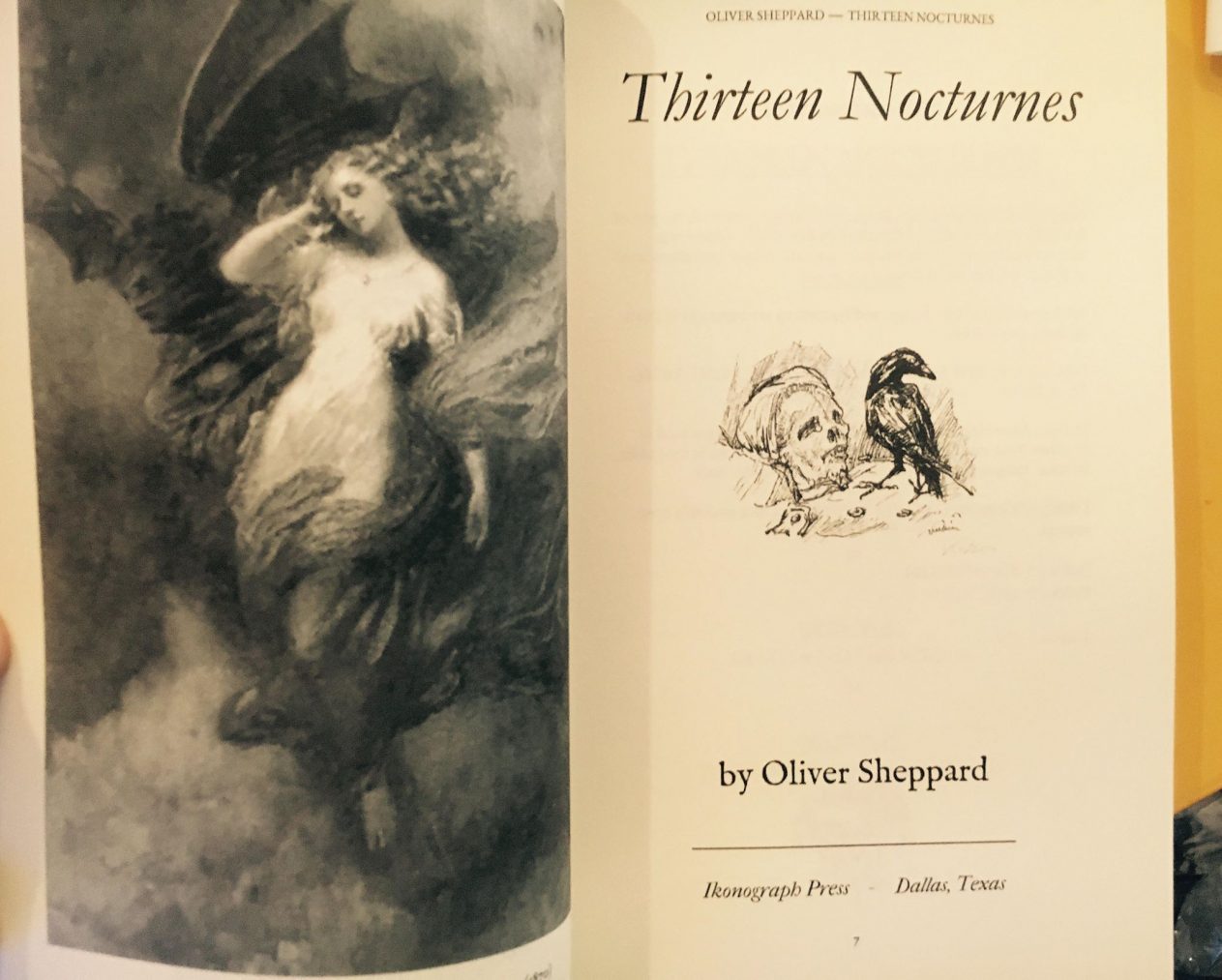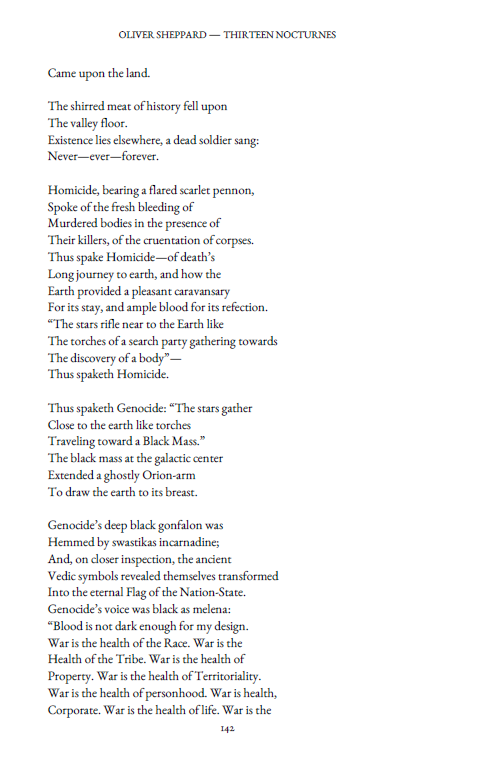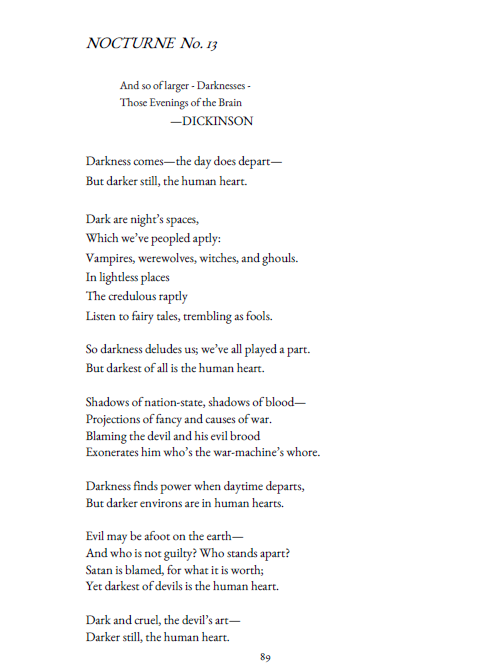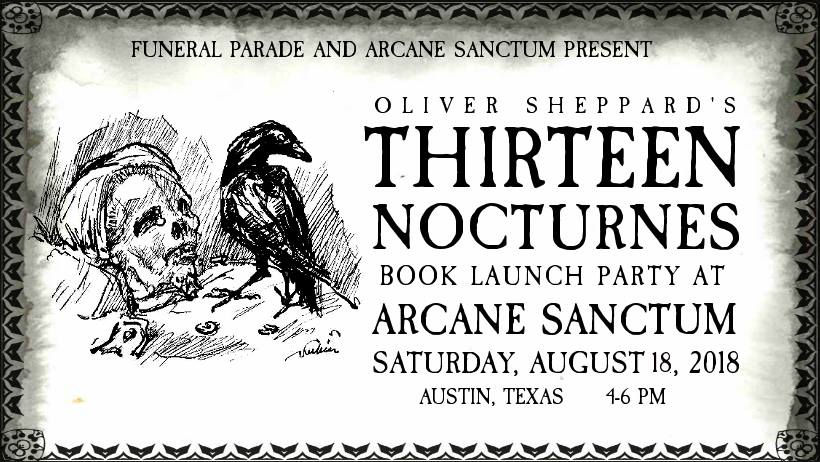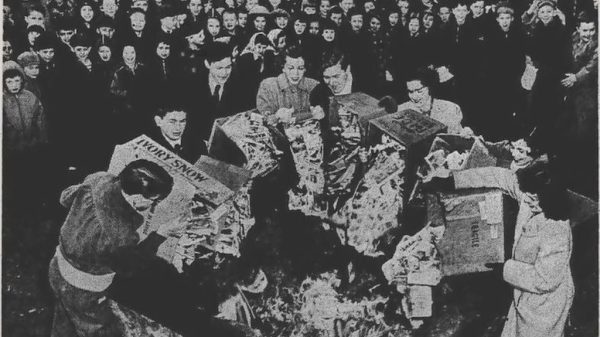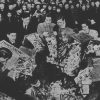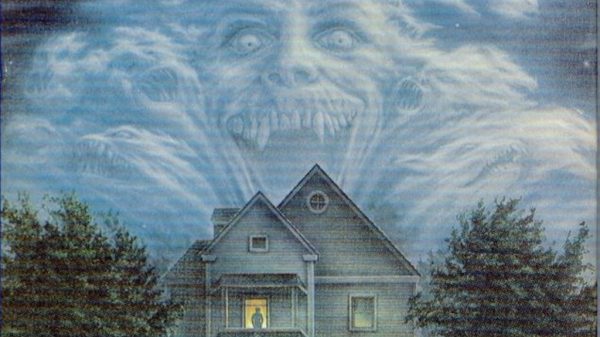Oliver Sheppard, who I’m sure many know as one of Cvlt Nation’s best writers, recently published his second poetry book Thirteen Nocturnes! This book is quite a specimen to behold. When I first received my copy, I could tell instantly it would fit perfectly on my bookshelf among the Anne Rice series, Edgar Allan Poe, and, given the music references, Go Ask Ogre. This book is gothic in every sense of the word; from the writing style, the themes, the art complimenting each well constructed page, to Oliver’s own influences.
What blows me away completely about Oliver’s poetry– and I know I’m not alone in this– is that it’s so rare in this day and age to find poetry written in such a sophisticated, profound manner. His work reads like that of the poets that inspire him, but in such a way that can’t be replicated. He combines a down-to-earth modernism with the old school style which makes for a fanciful and unique experience for the reader. Oliver paints detailed imagery with his words, inspiring and relaxing the imagination. I find his poetry more fun to read than that of the original poets because in spite of the tone, it’s written for a modern audience. That’s what makes it easier to digest, at least for me.
Without a doubt, this bountiful collection raises the bar for contemporary gothic poetry whether or not you’re familiar with the writer. You don’t have to I highly recommend curling up with this book and letting it suck you in before bed for some kickass dreams. Without further ado, here is my exclusive interview with Mr. Sheppard!
Q: When did you first begin writing? What do you think sparked the interest?
A: For me, the Holy Trinity of Poetry consists of William Blake, Edgar Allan Poe, and Charles Baudelaire. But William Blake, especially — the more so, the older I get. Discovering these three poets in my teens sparked my interest in writing the kind of poetry I write now.
About THIRTEEN NOCTURNES, my new book — my struggles with chronic major depression have probably led to my enjoying the three above poets, and this mood disorder, coupled with an inexplicable desire I’ve had to express myself since early adolescence — this sparked an interest in writing. I have chronic major depressive disorder (“single episode,” unipolar, clinical depression, lasting over many years) since at least my early teens, but probably earlier. Generalized Anxiety Disorder, Panic Disorder, and probably some other things are in the mix, too. My own melancholic moods — the Victorians apparently called this “getting the morbs” — informed the writing of the poetry that is in THIRTEEN NOCTURNES. I’ve had the morbs for a few decades now.
My life, normally, is really not very enjoyable. And maybe it’s led me to hold a worldview that’s colored my approach to literature. For me, there is probably no more perfect poem than Giacomo Leopardi’s “Night Song of a Wandering Shepherd in Asia” from 1820; it expresses a worldview that completely resonates with me. That poem has profoundly affected me. In it, Leopardi’s protagonist, a representation of himself, states, “To me, life is evil.” The philosophy of John Gray in his 2003 book Straw Dogs, or Peter Sloterdijk’s Rules for the Human Zoo_ which call into question the principles upon which forward-thinking, progressive humanist optimism is based, have dovetailed with my own interest in the writings of figures like Milton or Poe, and my own verse searches for syntheses of these things. THIRTEEN NOCTURNES is a part of my reckoning with a sense that there is an ultimate void or meaninglessness permeating everything. I’ve referred to it as “cosmic fatalism.” And I think it’s uncontroversially true that this is just how things are, especially if we are talking about broad time scales and our species’ own recent arrival on the scene. At the extreme end, a little over 3 billion years from now the Sun will have expanded to the point that earth’s oceans will dissolve into steam, and life will be impossible here, but it’s more probable it will be eradicated through human foolishness regarding the environment or nuclear proliferation well before then, in our own life times. Hoping for human space exploration and sustaining life elsewhere besides Earth just seems ridiculous if you study the truly incomprehensible distances involved and the amount of time, or life times, travel even within our own cosmic neighborhood would take, where nothing is really habitable except the small planet we’re already on. It’s a truism that things inevitably decay and die. I’m not sure how anyone could seriously argue that our collective prospects are not bleak unless they cite religion or the supernatural, and in fact this is why folks do seek greater meaning in religion or other forms of belief in supernatural deities, as a means to escape a bleak and discomfiting reality.
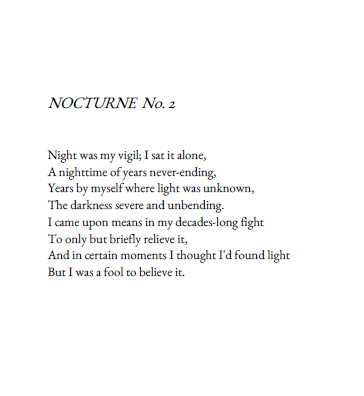
Reading current horror author Thomas Ligotti’s interviews about his own struggles with chronic anhedonia, major depression — and looking back upon poets like Edgar Allan Poe and Charles Baudelaire, who also suffered similar long-term depressive episodes — this has helped me cope with this sort of thing in my own life, and in fact it’s given me the confidence to even talk about it openly like this. Despite all the public campaigning about mental illness or how enlightened society has supposedly become, it’s amazing to still see some folks dismissing Ligotti as someone that needs to kill himself, because he evinces a cosmic pessimist worldview, and he should do that to prove he believes what he says. The internet has seriously degraded public discourse. Look at clickbait articles and the mentality they pander to. Communication in the 21st century is a postmodernist’s nightmare. Nothing makes any sense; people can self-select incoming information streams to create their own parallel realities. This is really the new dark age of the Anthropocene. There is a lot of detached viciousness that relishes in others’ suffering from afar, or even worse, finds sadistic amusement in it, via the internet. A new low in civilization, and yet people with degrees participate in it, too. Nothing really seems to matter. Pure moral solipsism. This sense of the collapse of meaning or of a shared, consensus reality informs a lot of the themes I have tackled in THIRTEEN NOCTURNES. Themes of disintegration, collapse, decay, things breaking down, malfunctioning, dying, people losing the ability to relate to one another or behave in meaningful ways toward each other — those are all themes I try to tackle.
Q: How long did Thirteen Nocturnes take to create and publish? Were there difficulties along the way?
A: I started work on THIRTEEN NOCTURNES in October of 2017, and the initial idea was to put out a small chapbook comprised of only thirteen poems — the titular thirteen “nocturnes,” which were to be a series of nocturnal poetic meditations. So, I had in mind a small, zine-like chapbook or even something like a pamphlet I could hand out at deathrock shows, or something like that. And thirteen separate nocturnes are indeed in the second section of the new book, but what was originally meant to be a chapbook became a single chapter in a larger book.
In the end, 85 poems came to comprise THIRTEEN NOCTURNES (86 poems if you count the “Dedication”), and the book is about 258 pages — so obviously I did not stick to my original plan!
Were there difficulties along the way? Yes. But I’m lucky to be at a point in my life where everything came together for me to be able to produce something like the two books I’ve written in the past year. Specific difficulties along the way: There have been deaths in the family, stressful family dysfunctions, financial crises, my hair has started to turn white (not grey, but fucking white!) in places I’d never suspect, pounds are harder to keep off, and I have begun to feel the dread specter of time pressing his hand to my back. I’ve had the urge to write, and to write creatively, for a very long time, but the clock is no longer my friend.
Q: Did you always set out to write poetry collections? How did this come to be?
A: I did not. I think you and a lot of others know me as someone that mainly writes about music — deathrock, postpunk, and other types of punk or dark music. But that’s a small part of what I’ve always been interested in writing about.
In late 2016 I was exploring the idea of starting my own small press to produce a collection of my own music writing, and was thinking of calling the book WARDANCE, after the music events I do in the Dallas area. But I’d never designed a book before, so instead I decided to compile a bunch of different poems I had sitting around in various notebooks, written in long hand. Those collectively became DESTRUCTION: TEXT I. That book came out about a year ago, in late July 2017, under the Ikonograph Press aegis. The impetus for compiling that book was my friend and fellow Texas poet Heather Blank’s collection CHARCOAL COCKTAILS, a book I recommend, and which I had bought off her around that time. Her inspiration motivated me to do something similar, so I chose some of my own favorite poems, some that I’d been hanging onto since middle school.
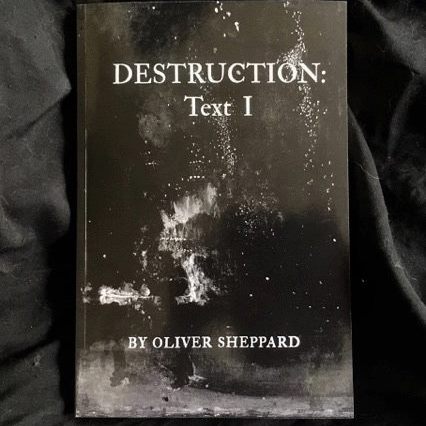
In the year since it’s come out, DESTRUCTION: TEXT has done very well. It’s sold a little over 500 copies from Amazon, and I have sold dozens more personally at shows and over PayPal and the like. 500 copies may not seem like a lot in the big scheme of things, and it isn’t, but for poetry it’s not bad, especially if you keep in mind that 1) hardly anyone actually reads poetry these days (although that is slowly changing with “Instagram poetry” and the like — something I have incredibly mixed feelings about), and b) this was a collection by a relatively unknown poet who did all the marketing, formatting, copyediting, hustling, etc. for the book himself, with no marketing department or big publisher helping him. I approached it the way a punk band would approach promoting or selling a DIY LP or EP. There are still a few copyediting errors in DESTRUCTION: TEXT I that make me cringe — stuff I caught only after the book had gone to press — but overall I’m happy with the course the book has taken. I think many people that read it are shocked that it is not really a straight-up collection of “punk,” “goth,” or “deathrock” poetry in maybe the way they might think, because they know me only from my music writing, or djing, or from the kinds of shows I book in Texas. But DESTRUCTION: TEXT I is altogether “dark,” regardless, I would argue. It’s just not punk poetry in the sense of Henry Rollins or John Cooper Clarke, et. al.
Sections in DESTRUCTION: TEXT I were inspired by different things: The “Functional Forms” section, for example, was inspired by postmodern and experimental verse and even some of the stuff I liked that I’d come across in Bruce Andrews’ recent L=A=N=G=U=A=G=E school of experimental poetry. The “Apocalypse of Man” section near the beginning, on the other hand, was inspired by Blake, Milton, and some of the late 19th century Symbolists. Maybe this sounds overly ambitious or high-falutin’, but DESTRUCTION: TEXT I was a serious attempt to try to contribute something meaningful to poetry in the English language. I wanted to produce something I could stand behind for a long time to come and which did not reflect a passing fad. I wanted it to respect the traditions of the past (Romanticism, Symbolism), but also to point towards the future and evince a familiarity with the current state of poetry in the West. I didn’t want to churn out a collection of throwaway, garbage verse or maudlin, angsty diary entries about rebelling against the system, breaking up with exes, or the dreaded “song lyrics as poems.” I think I did a pretty decent job, with some caveats. But I think I’ll only get better. I would like to work with a great editor. I guess we’ll see.
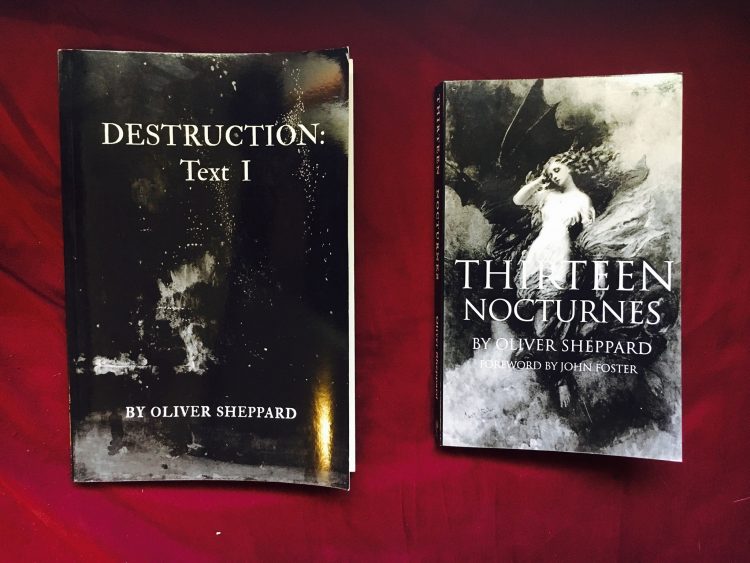
Q:Okay, you say you have mixed feelings about Instagram poetry, which I didn’t realize was a thing! Could you rant about that for a moment?
A: Hah, yes. Above, I mentioned “Instagram poetry.” That’s a new-ish phenomenon I have mixed feelings about. On the one hand, it’s very lucrative for some, like Rupi Kaur, who got a six figure advance for writing this sort of thing, which I believe may be the highest a poet has been paid for a first book since someone like Edna St. Vincent Millay. Instagram poetry is a phenomenon fueled mainly by millenials or those younger than millenials, actually — Generation Y or whatever the tag is for people in their late teens and in college nowadays. Basically, the writers buy old, used, manual typewriters and old linen paper and they will type very brief, pithy, poems, generally only 3 or 4 lines, sign their name to it, take a photo of it, and put it in Instagram. There they get shared and spread across the web. They often read like they are quotes from a larger poem — but they are not. I have a suspicion that these poems have been inspired by memes or pictures that these writers have seen of quotes from famous authors. Generally such quotes are excerpted from a larger body of work, of course, denuded from context. Rather than write such a large body of work, the Instagram poets make their own “quotes” which are, in fact, the entirety of the work!
Why I have mixed feelings: On the one hand, a lot of these poems are very, very bad, like angsty teen Facebook status updates or like very trite epigrams or aphorisms. And Rupi Kaur has a lot of short poems that are, in effect, relationship advice. I think she is in her early twenties, so I’m not sure how she’s become such a sage voice for relationship guidance, or why that occupies so much of her thoughts. I’m trying to think of Baudelaire or Poe writing three line relationship advice poems. (Honestly, they wouldn’t be ones to talk on that topic! They both could have used the advice, not dispensed it!) A lot of the poetry is just very insufferable to me, but maybe the majority of poetry any time is bad, anyway, regardless of the age. Some of these poets have made a lot of money. So that means more people are reading and buying poetry — which is a good thing. And, like I mentioned, a lot of these social media poets are pretty young, so who knows — in a few decades they may hone their craft and become very, very excellent poets. There are good and bad things about the phenomenon. Part of it is very much the hipster fascination with old, analog technology and nostalgia — the typewriters and stuff. But at least these kids are writing and sparking interest in poetry in general. A lot of people might get turned on to other forms poetry with Instagram poetry as a gateway drug of sorts to better stuff. Everyone starts somewhere.
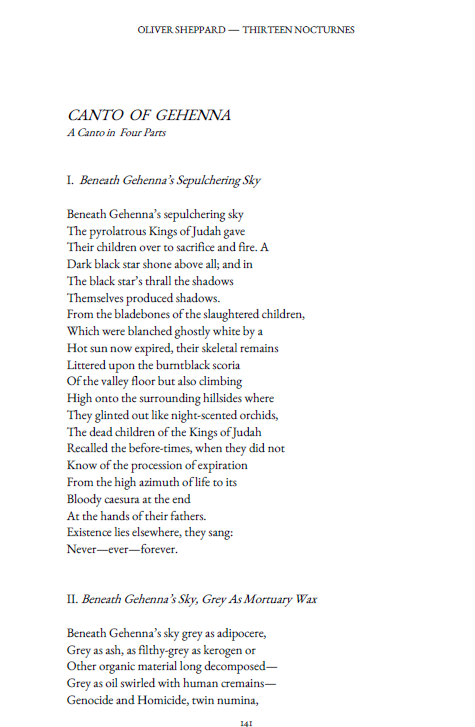
Q: How did this process compare with that of your last book?
A: THIRTEEN NOCTURNES is a consistently dark meditation mainly comprised of poems I began writing in autumn of 2017 and which I finished up around June of this year, 2018. The process of writing THIRTEEN NOCTURNES was like writing a novel. I would sit down every night and just start writing for hours, for months on end, many times until the sun came up. A lot of that time was spent revising, rewriting, revising again, throwing out stuff that didn’t work, starting from scratch, etc. The book design itself also took a lot more time than did DESTRUCTION: TEXT I. THIRTEEN NOCTURNES is a book I built from the ground up.THIRTEEN NOCTURNES and DESTRUCTION: TEXT I are apples and oranges. The latter is a compilation of poems from various parts of my life, with a wide range of subject matter. And THIRTEEN NOCTURNES is just more consistently “gothic,” or evinces more of a consistently cosmic fatalist worldview.
Q: Writing each night like that takes some hardcore dedication! Did you ever struggle with writer’s block? If so how did you work through it?
A; About writer’s block, I sort of get it sometimes, I guess. I have heard there’s no such things as writer’s block, that you should just write, and maybe what you crank out will be silly or terrible but if you simply push through you may happen upon a nugget of a great idea. I did force myself to write like this many times and suddenly a phrase or rhythm will pop out that I can work with. But, as I mentioned above, I generally get really good ideas when I am trying to go to sleep, so I have to jot them down to remember them for when I wake up. I generally have a problem of having too many ideas and not having the time or perhaps self-discipline to see them through to their full execution
Q: Were there a lot of poems that didn’t make the final cut?
A: Yes. As I mentioned above, there about 85 poems in THIRTEEN NOCTURNES and it runs to about 250 pages. I cut out about 70 pages’ worth — at least another chapbook’s worth — of material. That material may appear somewhere else, some other time. It was material that just didn’t fit the overall theme or mood of THIRTEEN NOCTURNES in a satisfying way.
Q: What is your writing process like? What’s your favorite part about creating such imagery-rich poetry?
A: I read for inspiration. Well-written prose inspires, or other interesting poetry, and then I have to have solitude to just sit and force myself to write. A lot of my best ideas come when I am laying in bed, trying to sleep, which is kind of unfortunate. I will grab my phone and peck out the ideas in the “Notes” app and then the next morning, when I’ve forgotten what I was thinking about, I can open that app and it’ll jog my memory. With that, I can usually recall what I’d been planning. Then I just have to make time to sit down and get it all out on paper. And that’s the hard part. You have to be able to turn the rest of the world off for many hours, or days. Or weeks!
My favorite part is just getting the work out there and exorcising it from myself. Recently I heard from someone that read THIRTEEN NOCTURNES and she said it helped her deal with a bout of depression she was going through. That was really nice to hear, given my own problems with that sort of thing.
Q: Were you a voracious reader as a child? Did you have a favorite book or series growing up?
A: Yes, but there are always new books I’m discovering — infinite little corners of literature that I’m finding out about all the time. I would give up half the books I’ve read or that I own now if I could increase my memory retention. For example, there are books I read in my teens and all I can recall from them are the impressions they’ve left with me. I read Mikhail Bulgakov’s MASTER AND MARGARITA when I was 15 or 16 and it had a huge, huge impact on me, yet I would be hard pressed to describe in detail what it was about now. I could only describe it in very general terms. This isn’t satisfying to me, and so I’ve been wanting to re-read it. I don’t like to blow through stuff quickly if I feel I am not going to retain it for very long afterwards. Because, then, what’s the point? I’ve tried to read slower and more deliberately as I’ve gotten older, to let things soak in. I like reading 19th century literature because you are forced to take a slower approach with it. You cannot scan or skim over much Romanticist or Victorian or Symbolist literature and really grasp it. As far as favorite series growing up, there weren’t really any young adult series I remember, but I enjoyed Choose Your Own Adventure-type books. The Steve Jackson horror-themed books were especially great; they seemed more mature — the creepy stuff like HOUSE OF HELL (or, as they had to retitle it in the US, HOUSE OF HADES). After that it was straight into Edgar Allan Poe and then of course HP Lovecraft and the early weird fiction authors, like Clark Ashton Smith. Baudelaire was a huge discovery at age 15 or so. By a fluke I discovered Andre Breton, the Surrealist writer, at age 13 and that had a major impact on me. Up until then I thought poetry was very flowery and ornamental stuff from centuries ago. It opened a door in the same way that discovering punk later did.
Q: I have to ask because your writing is just so good: have you ever taken philosophy/ethics or specialized writing courses?
A: I have taken a few. The best one I took was by a professor from SMU, Tom Stone, who was himself a student of John Hawkes at Brown University. He actually really turned me onto Hawkes, whom I quote at one point in THIRTEEN NOCTURNES. I took a writer’s retreat once that lasted a few days, also related to college. And I was awarded a two week residency at a writer’s colony in the late 1990s but I was unable to afford the trip up to the colony! Being poor sucks. The classes I’ve taken — I’m unsure how greatly they really have helped me. I wonder if I simply read and practiced and wrote anyway, without the feedback, if I’d have progressed the same. The jury is still out!
Yes, I’ve taken classes in Philosophy before, and enjoy it immensely. I’ve mentioned some of my favorite modern philosophers — John Gray and Peter Sloterdijk. And I like Thomas Ligotti’s THE CONSPIRACY AGAINST THE HUMAN RACE. About metaphysics and the occult, I'[ve not taken any classes; that’s more of a self-study topic for me. I do find occult and mystical traditions to be rich with inspiration, and in fact many incantations and the language of conjuring or of some “spells” are in fact excellent poems in and of themselves. I really enjoy reading that stuff.
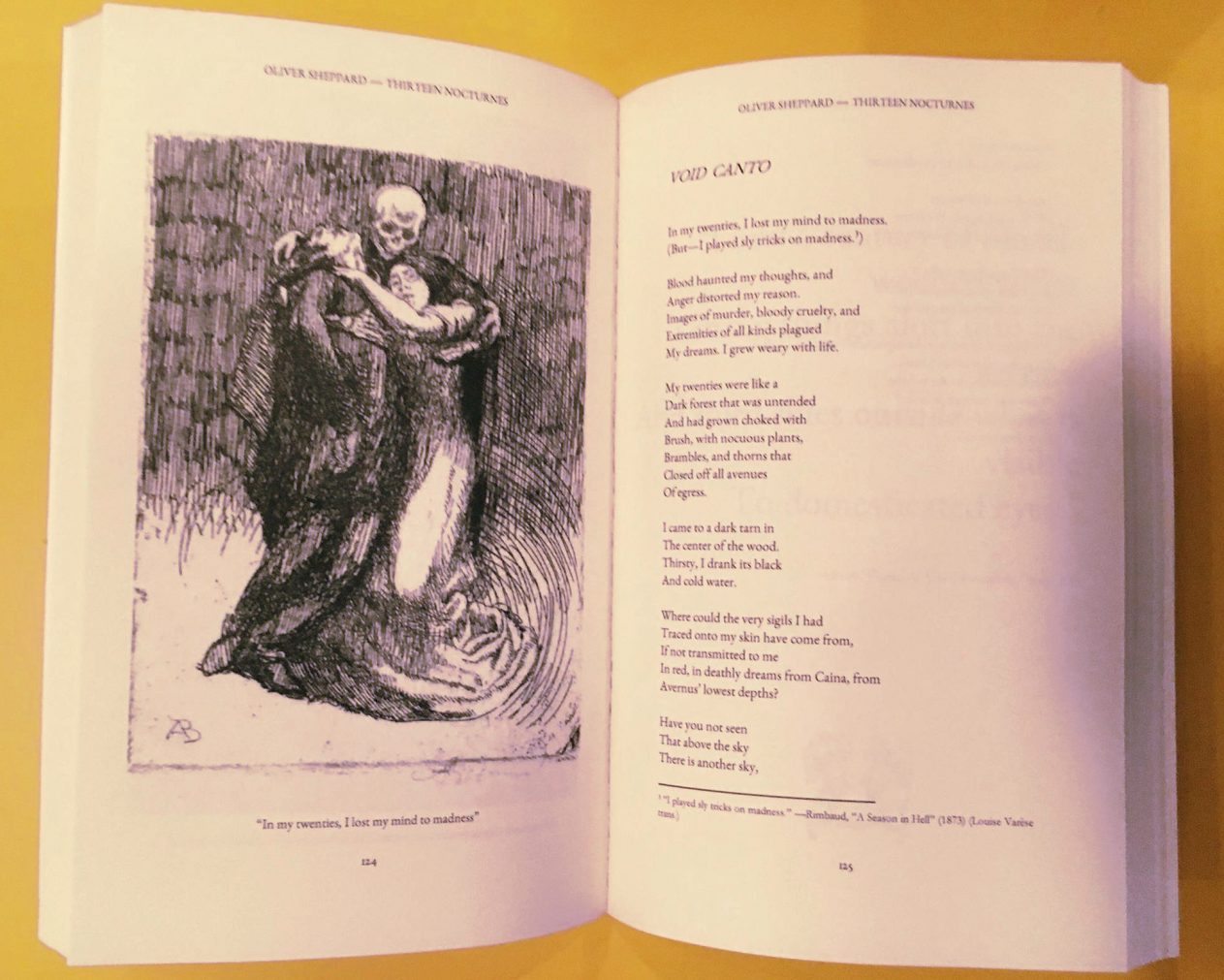
Q: What are some of your favorite poems in the book? Favorite art you included?
A: That’s a tough question. I’m proud of “Canto of Gehenna.” That was inspired by a lot of different things, like William Blake, of course, but also political theorist Randolph Bourne (who wrote “War Is the Health of the State”), and some parts of the Bible, as well as the Greek poet Xenophanes. I like “Nocturne No. 13” a lot. When I wrote that one, I was thinking of Emily Dickinson, hence the Dickinson epigraph at the head of that poem. “Canto of 99942-Apophis” is one I’m very proud of; that one was, in many ways, inspired by CRASS’s “Reality Asylum,” which might sound strange. It’s a poem I wrote and imagined being recited in Eve Libertine’s voice. In fact, I think “Canto of 99942-Apophis” would make a great dark ambient, soundscape-y type piece like “Reality Asylum” if the right person recited the lines the right way, and if the surrounding soundscape was done in the same “bad trip,” apocalyptic style that was used in “Reality Asylum.” Or if it were accompanied by something along the lines of CURRENT 93’s “Dogs Blood Rising”-type ambient music. I’ve thought about approaching some local industrial musicians with the idea.
“Canto of Asmodeus; or, New Proverbs of Hell,” was inspired by William Blake’s _Marriage of Heaven and Hell_ and especially the “Proverbs of Hell” section of that, wherein Blake purports to relay certain sayings popular in Hell that have been told him by a wandering demon. (It’s important to keep in mind that the statements in that poem are not necessarily my own beliefs, just as Blake did not pretend to relay in his “Proverbs of Hell” statements that he personally held to be true. They are literally supposed to be statements of an ethos from Hell, whatever that might be. Some statements may seem to make sense, and others may not.)
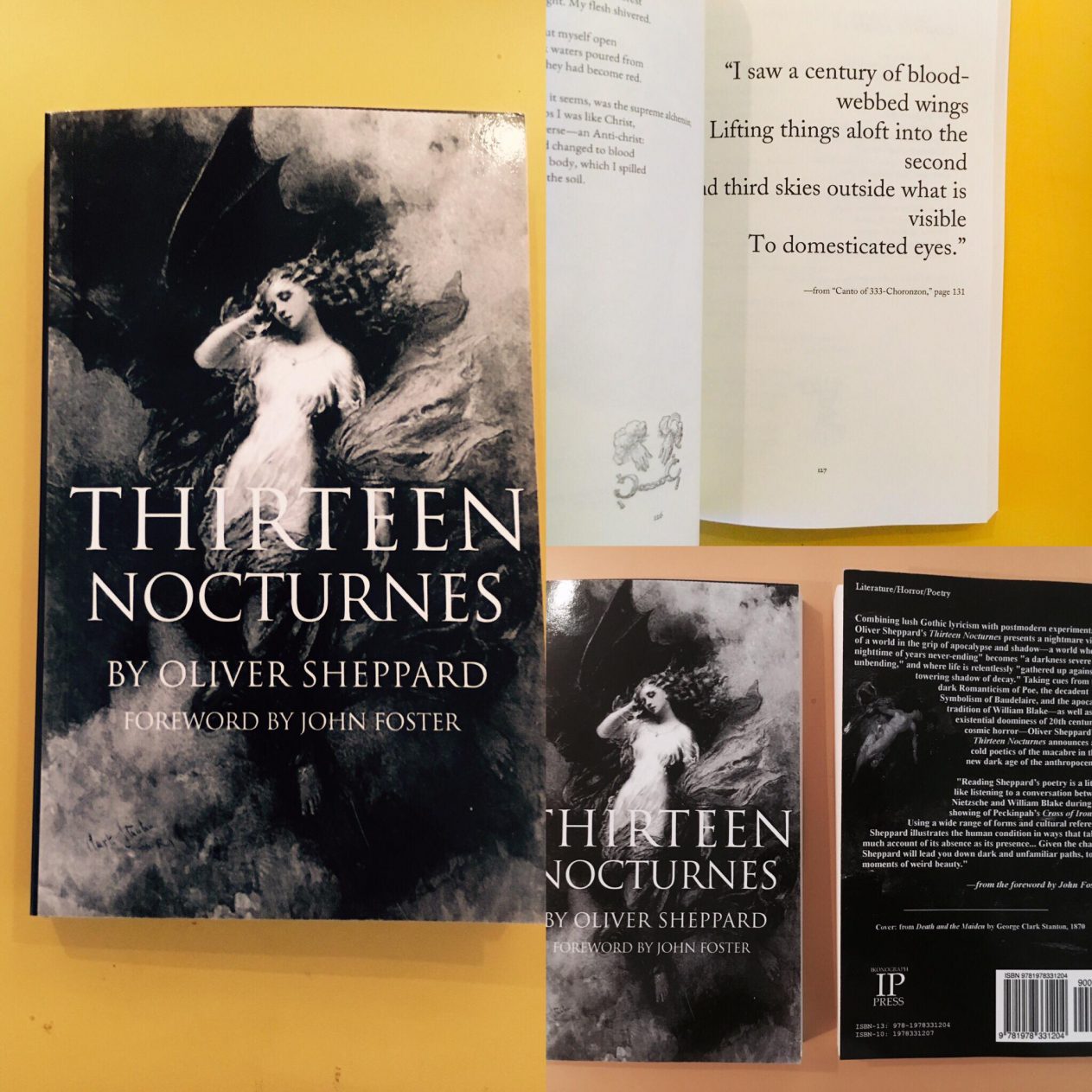
Of course, I like all the photography and art I included in the book, and happily it’s all public domain and/or from images created before 1923, although I have edited a lot of them. I used some early photography by the likes of Anne Brigman and George Stieglitz and many others. The photo I used for “Nocturne No. 12” — the gloomy tree silhouette — is by the 19th century photographer William Henry Fox Talbot, and it’s actually a calotype negative on salted paper from the 1840s. But it looks like it could be a black metal album cover to me! And a lot of early photography fascinates me precisely because of this: it’s grainy, mysterious, and haunting. So much of it is incredibly more evocative than a lot of the photography that exists today. The Anne Brigman photo I used for my poem “We, the Carrion Hearted,” which is a grainy photo of a woman who looks as if she is weeping on a cliff side, in a white dress, soaking wet, perhaps about to jump to her death, well, it’s amazing to me that that photo is from 1912.
The cover art on THIRTEEN NOCTURNES is from a watercolor from the 1870s by George Clark Stanton, “Death and the Maiden.” Coincidentally, I had meant to include that painting in the interior of the book only. But when I was worrying about what the cover of the book should be, I bounced some ideas off my friend Jack Control (of WORLD BURNS TO DEATH), and he suggested that that painting would actually make a good cover for the book, so I switched the cover over to that. I rendered it a bit in GIMP. (The original cover design was going to be a modified Edward Steichen photograph from the 1910s.) The 19th century woodcut that accompanies the poem “The Trees that Make the Gallows…” is another favorite, by WIlhelm Laage. It doesn’t look like it is over 100 years old, to me; it looks like something you’d see on the cover of a DISFEAR LP or something. The photography and art, by the way, are something else I had to scale back dramatically in the book; an early draft of THIRTEEN NOCTURNES was very photo- and art-intensive to the point I felt it detracted from the point of the book, which is my poetry and my own original content. Sometimes the best accompaniment to a poem really is empty, negative space. There is a solemnity to that. On my blog I’ll probably put up a list of all the photos and artwork in THIRTEEN NOCTURNES.
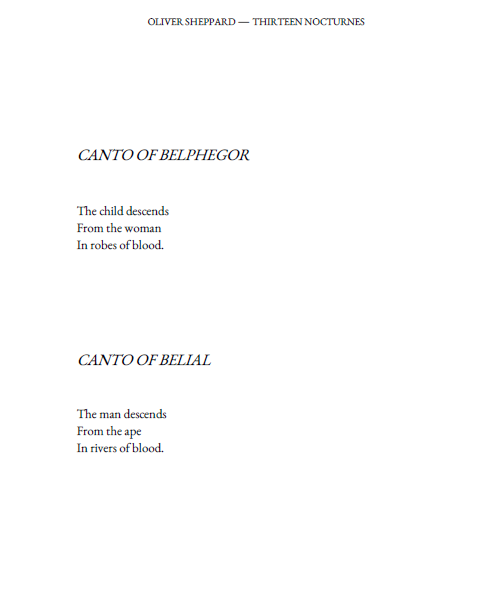
Q: What advice do you have for aspiring writers/poets?
A: Develop a thick skin and be persistent. You have to make time to write, of course, and exert serious self-discipline to complete what you start — which is still a problem I have, myself! And sometimes the rewards won’t seem worth it. You have to have a nearly irrational belief in yourself. It’s helpful to keep in mind a lot of Walt Whitman’s poetry was rejected by magazines of his day. Herman Melville’s _Moby Dick_ was a flop at first. Charles Dickens had to self-finance the publication of _A Christmas Carol_ because no publisher wanted to take a chance on it; they thought it would be a flop. Even Cormac McCarthy’s _Blood Meridian_ was met with mixed reviews initially, and now it’s considered one of the great works of American literature in the last 50 years or so. We all know of artists and writers that died penniless, shunned by audiences of their day, only to be rehabilitated decades after their death, generally after a well-placed critic championed their cause relentlessly or after other writers began citing that writer as a major influence. (For example, Baudelaire’s relentless championing of Edgar Allan Poe in Europe eventually found its way back to the US after some unfriendly critics tried to tarnish Poe’s reputation in America after his death.) My point is, regardless of how others perceive what you are doing, stick to it and do it anyway if you really believe what you’re doing is worthwhile.
And it should go without saying that you have to read others’ works. And read a lot in general. You just have to. (In fact, you should WANT to!) You have to make the time for it. If you can’t make the time to read or write, you should find another passion to devote yourself to.
Q: Can we expect another book in the works sometime?
A: Yes. I have an idea that I want Ikonograph Press, my own small press imprint, to publish others’ books. Davey Bales, of THE WRAITH and LOST TRIBE and others, is also a poet, as you know — you wrote a great piece about him for CVLT Nation, of course! Anyway, I’ve approached him a couple of times about either putting something of his out; or, another idea I have is an anthology of deathrock or dark punk poetry from folks in the scene. People like Jake Baker of PART 1, who had a book of poetry published by THE MOB’s All the Madmen label in England — and perhaps some of my favorite punk or deathrock lyricists that I also suspect are very good poets…. Just making a sort of anthology of writers in “the scene,” as it were. Additionally, there are some themed collections I have ideas for that I haven’t seen done before, comprised of some selected poetry from history.
I don’t know if more poetry collections by myself are in the works, though. I have a horror novel I’ve wanted to write. And a nonfiction book about Theda Bara that I was supposed to be writing when THIRTEEN NOCTURNES happed. I’ve a lot of good ideas that I am hesitant to spill the beans on… Just follow the Ikonograph Press page or my own blog at
oliversheppard.net and you’ll be kept apprised of developments.
Q: What can you tell us about your book signing on August 18?
A: I’ll be reading from, signing, and selling books in person on
Saturday, August 18 in Austin, Texas at the occult shop ARCANE SANCTUM. There’s a Facebook event page for it here:
https://is.gd/pATP5v (Or search for “Thirteen Nocturnes in-store.”) I’m also trying to cobble together a kind of speaking tour for later in August or in September. I’m djing KILLING JOKE’s show in Dallas on
September 17 so I’m hoping to be able to give a copy of my book to Jaz Coleman; there are a few KILLING JOKE lyrics quoted in some of the poems, and I’ve wondered what he’d think of that.
Additionally, you can buy THIRTEEN NOCTURNES for $13 USD on Amazon in America and in the UK here:
https://is.gd/r4gcYJThanks so much, Sar! It’s good to hear from you!


